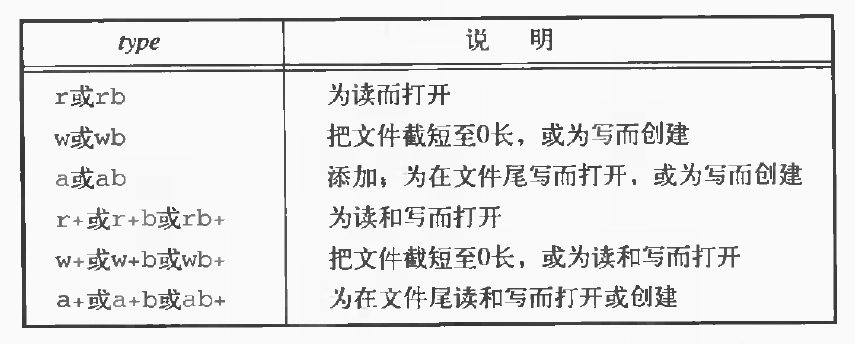apue学习笔记(第五章 标准I/O)
来源:互联网 发布:辽宁体育频道直播软件 编辑:程序博客网 时间:2024/05/16 17:57
流和FILE对象
对于标准I/O库,它们的操作是围绕流进行的。流的定向决定了所读、写的字符是单字节还是多字节的。
#include <stdio.h>#include <wchar.h>int fwide(FILE *fp,int mode);
fwide函数可用于流的定向。根据mode参数的不同值,fwide函数执行不同的工作
若mode参数值为负,fwide将试图使指定的流是字节定向的
若mode参数值为正,fwide将试图使指定的流是宽定向的
若mode参数值是0,fwide将不试图设置流的定向,但返回标志该流定向的值
当一个流最初被创建时,它并没有定向。若在未定向的流上使用一个多字节(单字节)I/O函数,则将该流设置为宽(字节)定向。fwide并不改变已定向流的定向。
标准输入、标准输出和标准错误
对一个进程预定义了3个流:stdin、stdout、stderr。
缓冲
标准I/O提供了以下3种类型的缓冲
1 全缓冲,在这种情况下,在填满标准I/O缓冲区后才进行实际I/O操作。如磁盘上的文件通常实施全缓冲。
2 行缓冲,在这种情况下,当在输入和输出中遇到换行符,标准I/O执行I/O操作。如标准输入输出。
3 不带缓冲,标准I/O库不对字符进行缓冲存储。标准错误流stderr通常是不带缓冲的。
我们可以调用下面两个函数更改缓冲类型
#include <stdio.h>void setbuf(FILE *restrict fp,char *restrict buf);int setvbuf(FILE *restrict fp,char *buf,int mode,size_t size);
可以使用setbuf打开或关闭缓冲机制,参数buf指定一个长度为BUFSIZ的缓冲区。将buf设置为NULL可以关闭缓冲。
使用setvbuf,我们可以精确地说明所需的缓冲类型。这是用mode参数实现的:
_IOFBF 全缓冲
_IOLBF 行缓冲
_IONBF 不带缓冲
我们可以通过fflush函数冲洗一个流
#include <stdio.h>int fflush(FILE *fp);
打开流
下面3个函数打开一个标准I/O流
#include <stdio.h>FILE *fopen(const char *restrict pathname,const char *restrict type);FILE *freopen(const char *restrict pathname,const char *restrict type,FILE *restrict fp);FILE *fdopen(int fd,const char *type);
type参数指定对该I/O流的读、写方式,ISO C规定type参数可以有如下15种不同的值

其中b作为type的一部分,这使得标准I/O系统可以区分文本文件和二进制文件
调用fclose关闭一个打开的流
#include <stdio.h>int fclose(FILE *fp);
读和写流
以下3个函数可用于一次读一个字符
#include <stdio.h>int getc(FILE *fp);int fgetc(FILE *fp);int getchar(void); //等同于getc(stdin)
对应上面所述的每个输入函数都有一个输出函数
#include <stdio.h>int putc(int c,FILE *fp);int fputc(int c,FILE *fp);int putchar(int c);
每次一行I/O
下面两个函数提供每次输入一行的功能
#include <stdio.h>char *fgets(char *restrict buf,int n,FILE *restrict fp); //buf为缓冲区地址,读入的行将送入其中,参数n指定缓冲的长度char *gets(char *buf); //不推荐使用
fputs和puts提供每次输出一行的功能
#include <stdio.h>int fputs(const char *restrict str,FILE *restrict fp);int puts(const char *str);
二进制I/O
下列两个函数执行二进制I/O操作
#include <stdio.h>size_t fread(void *restrict ptr,size_t size,size_t nobj,FILE *restrict fp);size_t fwrite(const void *restrict ptr,size_t size,size_t nobj,FILE *restrict fp);
参数size为欲写结构的长度,nobj为欲写的元素个数,函数返回的是读或写的对象数。这些函数有以下两种常见的用法
float data[10];if(fwrite(&data[2],sizeof(float),4,fp)!=4) err_sys("fwrite error");
//读写一个结构struct{ short count; long total; char name[NAMESIZE]; }item;if(fwrite(&item,sizeof(item),1,fp)!=1) err_sys("fwrite error");
定位流
有3种方法定位标准I/O流
#include <stdio.h>long ftell(FILE *fp); //若成功,则返回当前文件位置指示,出错则返回-lLint fseek(FILE *fp,long offset,int whence); void rewind(FILE *fp);
除了偏移量的类型是off_t而非long以外,ftello函数与ftell相同,fseeko函数与fseek相同
#include <stdio.h>off_t ftello(FILE *fp);int fseeko(FILE *fp,off_t offset,int whence);
下面函数是ISO C标准引入的
#include <stdio.h>int fgetpos(FILE *restrict fp,fpos_t *restrict pos);int fsetpos(FILE *fp,const fpos_t *pos);
格式化I/O
格式化输出是由printf函数处理的
#include <stdio.h>int printf(const char *restrict format,...);int fprintf(FILE *restrict fp,const char *restrict format,...);int dprintf(int fd,const char *restrict format,...);int sprintf(char *restrict buf,const char *restrict format,...);int snprintf(char *restrict buf,size_t n,const char *restrict format,...); //参数n指定缓冲区长度
执行格式化输入处理的是3个scanf函数
#include <stdio.h>int scanf(const char *restrict format,...);int fscanf(FILE *restrict fp,const char *restrict format,...);int sscanf(const char *restrict buf,const char *restrict format,...);
临时文件
ISO C标准I/O库提供了两个函数以帮助创建临时文件
#include <stdio.h>char *tmpnam(char *ptr);FILE *tmpfile(void);
tmpnam函数产生一个与现有文件名不同的一个有效路径名字符串
tmpfile创建一个临时二进制文件(类型wb+),在关闭该文件或程序结束时将自动删除。
- apue学习笔记(第五章 标准I/O)
- 《APUE》笔记-第五章-标准I/O库
- APUE学习: 第五章, 标准I/O库
- APUE-第五章学习-标准I/O库-习题
- APUE学习笔记3——第五章——标准I/O库
- apue 第五章 标准i/o库
- apue学习第九天——标准I/O库(第五章)
- APUE读书笔记-第五章 标准I/O库
- APUE学习笔记——标准I/O库
- APUE学习笔记——标准I/O
- apue学习笔记(第三章 文件I/O)
- apue学习笔记(第十四章 高级I/O)
- APUE第5章标准I/O库 笔记
- APUE学习:标准I/O库
- apue 第五章 stand I/O
- APUE学习笔记——第三章文件I/O
- APUE学习笔记第三章文件I/O
- 学习笔记(study notes)-APUE中的File I/O
- 小知识点 - 串口输出数
- poj(1088)——滑雪(经典递推型动归)
- apue学习笔记(第一章UNIX基础知识)
- apue学习笔记(第三章 文件I/O)
- apue学习笔记(第四章 文件和目录)
- apue学习笔记(第五章 标准I/O)
- apue学习笔记(第六章 系统数据文件和信息)
- apue学习笔记(第七章 进程环境)
- apue学习笔记(第八章 进程控制)
- apue学习笔记(第九章 进程关系)
- apue学习笔记(第十章 信号)
- apue学习笔记(第十一章 线程)
- apue学习笔记(第十二章 线程控制)
- 1055. The World's Richest (25)


